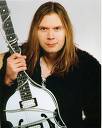The Art of Playing Jazz Guitar
 Best Guitar Lesson
Best Guitar LessonI'm not going to kid you; playing Jazz Guitar is extremely difficult at best and almost downright impossible at worst. However there are things you can do to improve your improvisation skills and feeling and we'll discuss them throughout this multi part series so look for additional parts in the near future.
Practice
What can I say about practice? Just do it and do it often! Do it everyday. When you think you have done enough do it again.
I am not just talking about picking up the guitar and playing a few songs I am talking about real practicing for the environment that you will eventually be playing in which is, of course, in an ensemble with other musicians who we hope will always be better than you.
Here are the basics...
When practicing always use a metronome!
If I didn't make that part clear perhaps this may help: ALWAYS USE A METRONOME!
If you feel that you don't need a metronome stop reading this article, stop practicing and go get some ice cream because you will get the same or even better results and you certainly will enjoy yourself a whole lot more in the process if you do. If you are committed read on.
Still with me?
When using your metronome try to feel your timing on different clicks. For instance for a swing feel have your metronome click on beats 2 and 4 rather than 1 and 3. This will give you an instant swing feel and also take away that nasty crutch so you are forced to know where beat 1 really is.
We never, ever, want to rely on our drummer, who may be in the middle of a complex experimental improvisation just when you need him/her the most, to tell us where beat 1 is. How many times have you been in that situation?
Sound simple? It is!
Sound easy? Try it for a month and you let me know how it goes.
Let's delve into this a little. When practicing using this technique of displacing metronome clicks for beats try these: practice a 3/4 tune using the metronome clicking once per measure and only on beat 2. Then switch to only on beats 3. See how the feeling changes. Practice it, learn it, feel it and then you can start to own it.
If you want to get fancy place the metronome to click every fifth beat while you play a tune in 3. This will shift the accents and feeling from bar to bar and will also allow your brain to break free from it's learned behavior which is designed to make you not want to think.
What did you say?
That's right! More times than not the human brain is your biggest enemy. It always seeks comfort and practicing in the fashion described above is not at all comfortable for your brain. In these cases I recommend telling your brain what my son often likes to say, "To bad..., so sad!"
We as musicians need to experience and comprehend the natural tendencies of the brain's normal behavior so we can learn to truly challenge ourselves to open up our minds to the gargantuan creative possibilities that await us when we do. This doesn't happen by accident nor does it happen by itself nor will it come easy. It takes an extreme effort on our parts.
Whether you have your instrument with you or not you can practice your timing. If you get a small battery operated metronome, which I recommend, you can bring it with you when you are driving back and forth to work. Practice the above examples in your car while singing. Don't worry if you can't sing you are trying to own these feelings and if you can't articulate these feelings with your voice you will never truly own them.
I have outlined several examples for displacement of beats. The idea is simple enough so that you can come up with more deviations on your own and you should keep changing them when you practice.
The point here is that true understanding and your eventual ownership of various beats and feelings associated with them do not reside strictly inside those beats and feelings. By looking only inside the beats you are shutting off all creative thinking that is necessary to truly exploit their full potential.
Real understanding resides outside and you must find out what that means. To truly find it you must force yourself and be willing to look everywhere else but the beats themselves. This simple metronome technique will get you started and point you on your journey to achieving that goal. Don't limit yourself to applying this technique only to timing but that statement is for another part of this series.
Have fun, practice and always play your heart out!
Best Guitar Lesson




